GUTTER REPAIR GUIDE
High winds, snow and ice, clogged gutters, or even pests like birds cause damages to your gutter system that requires gutter repair. The number one cause of all gutter repair issues is what we call gutter neglect.
Neglecting your gutters is when you forget about your gutters for a couple seasons or years and they become filled with debris all over. Once the downspouts become clogged the water can no longer drain properly. This is where almost all gutter related problems occur. When the gutters fill with water or wet debris and water they become very heavy. The weight puts a huge burden on the hardware and the fascia board. The result is gutters pull themselves from the wall.
If you think you need gutter repairs, this guide will help you identify the symptoms to figure out the cause.Keep in mind this guide mostly pertains to K-Style Aluminum guttering. Other types and styles of gutter will have their own unique way to diagnose issues.
STEP 1: OBSERVE YOUR GUTTER SYSTEM
Every home owner should be keeping an eye on their gutter systems, especially during the Spring and Fall. When the gutters get clogged from debris, it starts to cause other problems. Something as simple as a once a month walk through, can save you a lot of hassle and money down the road.
Take a walk around your home on any given day to look for problems or issues. Here is a list of things you can check any day of the week.
DEBRIS ACCUMULATION
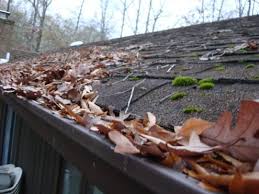
The very first thing you should be checking, is if your gutters have visible debris piling up in them. If you can see debris from the ground, chances are the gutter is full as well.
Debris in the gutter leads to gutter clogs. Clogs in the gutters or downspouts are the main route of ALL problems associated with your gutter system. If you want to avoid needing gutter repairs, you need to get your gutters cleaned regularly.
How often to clean your gutters depends on the tree coverage in your area, and the types of trees around your home. Here is some more information regarding cleaning gutters and how often:
CLICK HERE for more information on gutter cleaning.
LOOSE GUTTERS

Loose gutters are usually easy to identify, and one of the easiest gutter repairs. There are a few things that you can spot to tell if your gutters are loose or are coming loose just by walking around your home.
Whenever you can see a strip of sky between your gutter and the wall, that gutter is definitely loose and should be taken care of soon. Even if your gutters have just a small visible gap between them and the fascia board, then that gutter needs to be re-secured. The rule of thumb is, if you can see the gap from the ground, it is loose.
Take some steps back from your home to see if the gutter appears to be straight all the way across. If the gutter is sagging in one section, the water gets stuck there and isn’t able drain properly. Sagging gutters need to be re-secured, some times even re-pitched.
The last thing to look for, is if the front lip of the gutter is starting to pull down. (See the picture above) If you can see inside the gutter from the ground, it may be loose or possibly the tilt is off. If your gutter forms a lip, like the above picture, the water will pour right over this like a spout.
For more information on loose gutters, check out this article: https://mygutterpro.com/why-do-gutters-come-loose/
LOOSE GUTTER SPIKES

Loose gutter spikes can easily be seen from the ground. Gutter spikes are essentially a big nail that drives through the gutter and into the fascia board of your home. They are what mounts and holds the gutter to the wall. Gutter spikes are one of many ways to install a gutter. In fact, gutter spikes are the old school way of doing it. So less and less homes will have these. This section of the guide only pertains to you if you have visible gutter spikes.
If the gutter spikes are hanging out like in the picture above, they need to be tapped back in. If you can reach these from a ladder, this is an easy task to do. You can use a hammer or even a rubber mallet to simply drive the spike back into it’s hole.
Whenever you have a large number of gutter spikes sticking out in one area, then there may be something else going on. For example, the fascia board could be starting to rotor. Also, when the gutter is holding water in one area from not being able to drain properly, it will pull the gutter loose.
Keep in mind the hole gets wore out over time. The more times you re-nail the gutter spike in, the looser it gets. Eventually, they will no longer hold and the gutter will fall off the home.
CLICK HERE for more information on loose gutter spikes.
GUTTER SPIKES MISSING
Missing Gutter Spikes is a pretty easy one to notice. First you’ll need to determine if gutter spikes were used on your gutters. Simply take a walk around your home and you’ll see them in the gutters about every 18 inches if you have them.
If the gutter spike is missing, there will just be a hole in the gutter where the spike is supposed to be. When the spike is missing, water is able to pour right out of that hole. Another problem to consider is, if a spike is missing then that area isn’t being secured properly and a heavier burden is being put on the other spikes. Meaning it will help the other spikes come loose faster.
If your gutter spikes have fallen out and you can’t find them, you can purchase them at most hardware stores that carry gutter supplies. All you need to do is nail it back into the hole. However, most people will replace a fallen gutter spike with a threaded gutter screw. This will ensure that it actually grabs hold of something solid and provides support.
SAGGING GUTTER
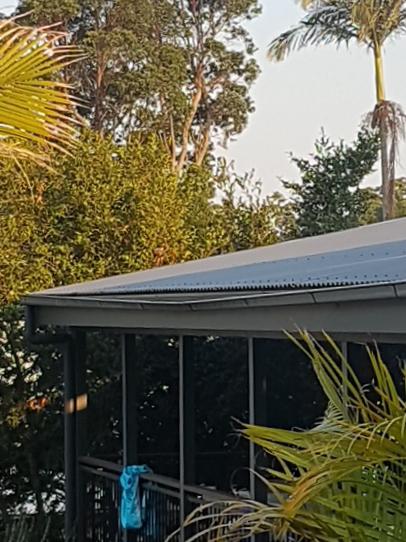
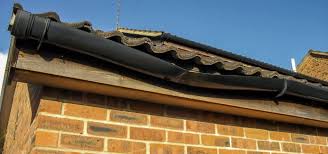
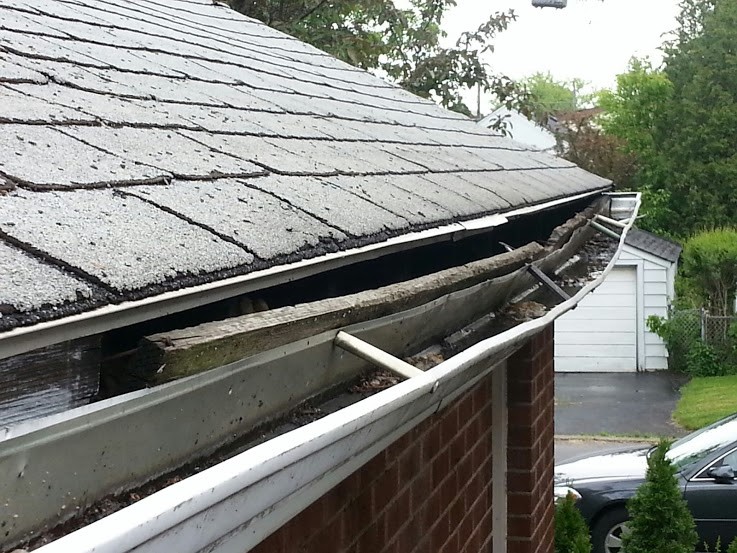
Sagging gutters occur when the gutter has come loose in one area. This most often occurs on longer gutters in the middle, but it could occur anywhere. It is easy to spot as the gutter will “dip” in one area instead of being straight like the rest of the gutter.
Gutters that are sagging are a simple gutter repair. They just need to be re-secured with new hardware. We always recommend using the new style of screw in hidden hangers over any style of gutter spikes that drive through the face of the gutter.
If you let your sagging gutters go for too long, they will eventually pull off of the wall and fall down. Sometimes they will bring some of the fascia board along with them. Anyway, you can avoid this by keeping an eye out for sagging gutters, and getting them fixed before it’s too late.
GUTTER PITCH

All gutters, no matter what type, style or size, are installed at a slope or angle so that they can drain towards the downspouts. This ensure the water easily flows in the correct direction and drains properly. Re-pitching gutters is a simple gutter repair. Keep in mind you have to re-pitch the entire gutter to set the slope correctly throughout the entire length of gutter.
Gutter pitch is a little harder to spot at first, but once you know what you’re looking for it becomes easier to notice. Wherever the downspout is located on the gutter, should also be the low point. So, the end opposite the downspout should be the high point of the gutter. Moreover, if you have two downspouts on one gutter, the high point will be the middle of the gutter. Placing the peak in the middle of the gutter makes the water drain to the left and right downspouts.
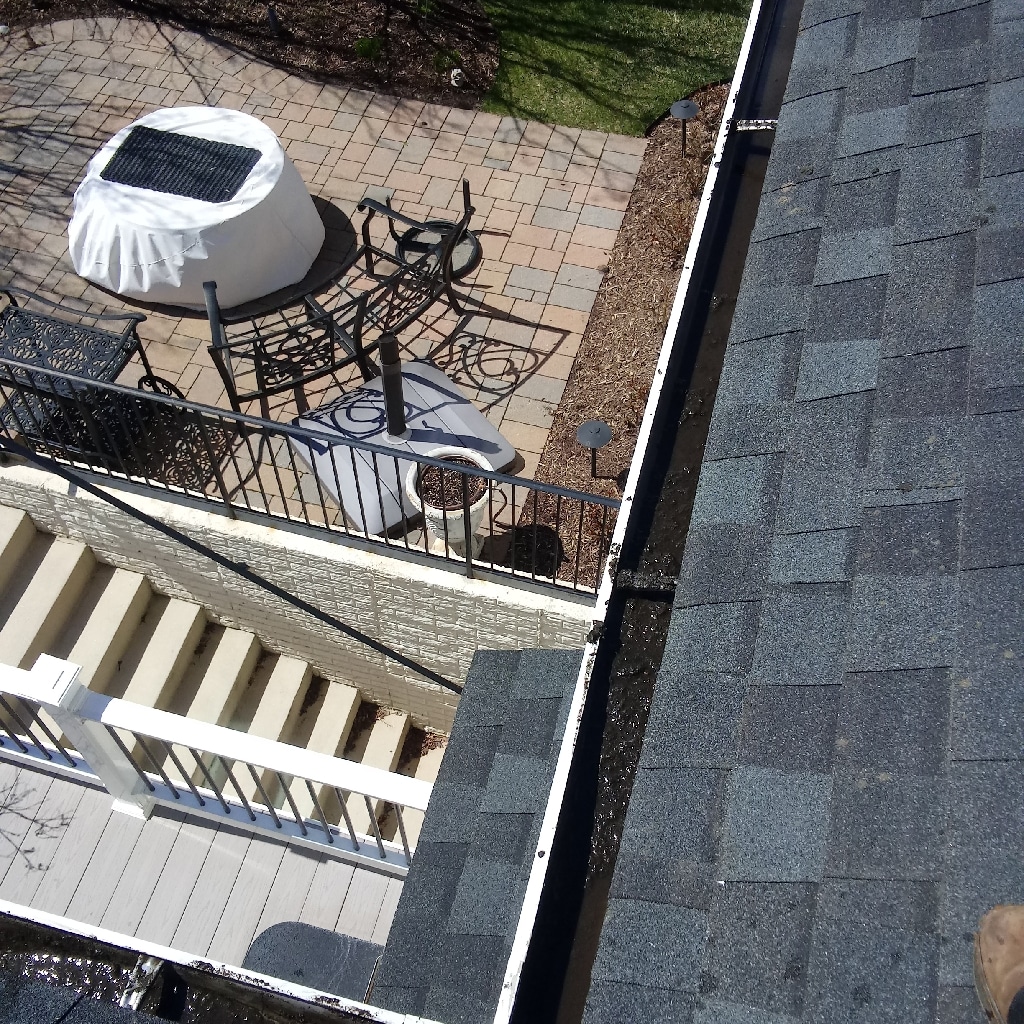
Over time gutters will flatten out, or lose their pitch. When this happens the water pools up and eventually over flows. If left unchecked the gutter will eventually back pitch, that’s when the gutter is tilted in the wrong direction. Basically, water can’t flow up hill. Therefore, if you see water going over the end opposite the downspout, your gutter is likely back pitched.
Here’s some more info on Re-pitching gutters.
WATER DAMAGE TO FASCIA BOARD
Fascia Board is the trim board that the gutters are mounted to. It is usually painted white and sometimes even wrapped with aluminum.
When water is able to get behind the gutter, it wears down the fascia board. Over time, enough water damage to the board will cause it to rot. Once the board is rotting, it becomes soft and no longer supports the gutter system. Fascia Board with water damage needs to be replaced.
There are a few things that could be causing the water to go behind the gutter and damage the fascia board. Things like gutter clogs, loose gutters, and pitch issues are the first things we check. Also, water damage to the fascia could indicate a problem with your roof, like a roof leak or missing flashing and/or drip edge.
CLICK HERE for more information on damaged fascia board.
WATER DAMAGE TO SHINGLES

Water damage to shingles is easy to notice. Whenever you have an upper level gutter that drains out onto a lower level roof, that water washes away your shingle grit and ruins your shingles. Over time the shingles will warp and become ineffective.
Any time you have a downspout releasing water onto your roof, we recommend extending it into the lower level gutter. Here is some more information on how and why: https://mygutterpro.com/downspout-extensions-connect-gutters/
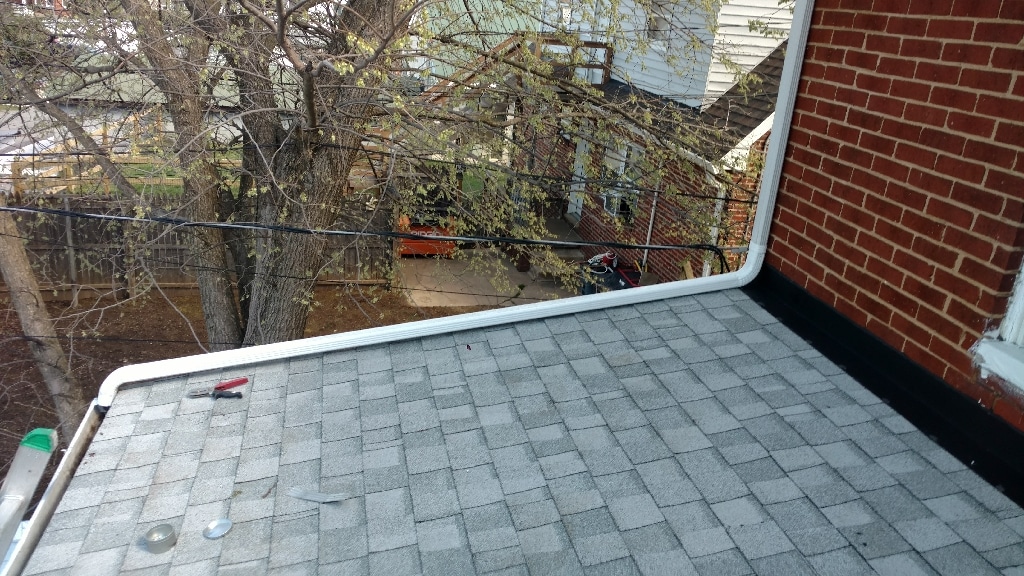
DENTED GUTTER
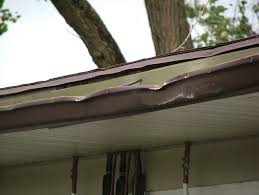
Whenever something like a tree branch falls onto your home, it often damages the gutter. Large amounts of snow or ice accumulation can also cause dents to form in the gutter.
Gutters that are dented too badly no longer sit flush against the wall. This allows water to get behind the gutter and damage the fascia board. The water could also run down the wall and get into windows or doors below.
Dented gutters often form a lip or spout on the gutter that the water pours over. Unfortunately, there is no simple gutter repair for a dented gutter. Most of the time you need to replace the gutter. A good rule of thumb to go by, is if the gutter is no longer sitting flush to the wall or it forms a lip on the front, it will need to be replaced.
HOLES IN GUTTER / RUST IN GUTTER
Whenever you have holes forming in your gutter, it usually means the gutter is rusting through. The only other way to get holes are punctures from damages, like a large tree branch falling into the gutter.
Aluminum guttering is rust proof for the most part. But under the right circumstances, your gutters can rust or corrode. This mainly is caused by extreme temperature fluctuations , which will also cause your gutters to warp. But, it could also come from overly acidic pollen collecting in your gutters. When moisture and acidic pollen combine, they eat the outside layer of the aluminum (over time) and eventually they get through and begin to rust and corrode the gutters.
Basically the rule of thumb is this, if you have rust holes starting to form in your gutter, that gutter needs to be replaced. Applying caulk or sealant to the hole may be a short term solution, but where there is a couple rust holes, more and more rust holes will be forming soon enough. You can sometimes lightly sand rust off your gutter to preserve it for a little longer, especially if you catch it early.
CLICK HERE for more information on gutter rust or corrosion.
GUTTERS/DOWNSPOUTS MISSING BRACKETS/STRAPS
One of the easiest things to notice is if your gutters or downspouts are missing straps or brackets. Straps are another way to hang the gutter besides gutter spikes. They go around the outside of the gutter and are installed every 18-24 inches like gutter spikes. It looks like a thin strip metal on the outside of the gutter every couple feet.
If your gutters have gutter spikes, than there won’t be any straps holding it up. So missing straps wouldn’t pertain to you.
Downspouts almost always have the same type of bracket on them that goes across the face of the downspout. It’s basically a small strip of aluminum that gets screwed into the wall on both sides. If these are missing, they are easily replaced. You can purchase these and re-install them easily if you have a ladder that reaches.
Missing downspout straps will eventually cause your downspout to come off the wall. Missing gutter straps will put more burden on the other straps, which will cause them to come looser faster over time. Neither of these issues are emergency issues, but you should keep an eye on it and have it taken care of during your next gutter cleaning service.
STEP 2: OBSERVE YOUR GUTTER SYSTEM DURING RAIN
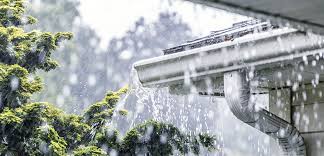
To identify most issues with your gutter system you must observe the gutters during rain. Unfortunately, coordinating your local gutter company to show up during rain is nearly impossible. That’s why we always stress how important it is as a home owner, to observe your gutters during rain. This will help you identify where the problems are, and possibly what is causing the issue.
DOWNSPOUT FLOW
The first thing to check when it is raining, is the water flow coming out of all your downspouts. If you notice that one or more of the downspouts barely has any water coming out of them, than those gutters/downspouts are likely clogged.
Whenever there is just a trickle of water, or almost no water at all coming from one particular downspout, than that downspout is very likely clogged. Nothing else will completely stop the water from coming out of a downspout like a clog. Therefore, that let’s you know right away that you need your gutters and downspouts cleaned.
If you have high flow of water coming out of your downspout, but the gutter above is pouring water over, than the gutter itself probably has other issues besides clogging.
WATER POURING OVER NEAR DOWNSPOUT
Check out this video that shows how water will leak from a clogged downspout. At first look it appears the water is dripping from under the gutter, kind of like the gutter is leaking. However what is actually happening is the water is flowing across the face of the gutter to where it drips from the bottom of the gutter. This is a tell tale sign that the downspout is clogged because the water is not draining.
Another good sign that your downspout is clogged, is when you have water pouring over the gutter close to the downspout. That’s a very good indication that the downspout is clogged. The water isn’t able to make it through the downspout, so it over flows in the same location.
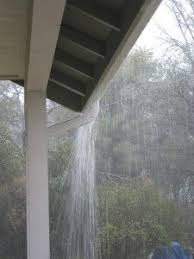
The only other things that could be causing the water to pour over the gutter near downspout are:
- The gutter is loose from the wall in that location
- When the location is directly under a roof valley and there is too much water force in that area causing it to spill over
- The roof is steep and the water gathers speed
- Or there is a problem with the roofing edge itself
WATER POURING OVER MIDDLE OF GUTTER
Often times water will pour straight over the middle of a gutter section. Especially on longer gutters. The problem is, that middle is sometimes right above your front door and water falling there is no good.
Whenever you have water pouring over the middle of a section of gutter, (but not on the sides) that usually indicates a loose gutter. However, there are a couple other things that it could be as well.
- Gutter clogs/debris in gutter
- Roof is too steep
- Gutter pitch/slope is incorrect
- Problem with the roof or roof edge
Roofs that are steep will force the water to speed up, and if you have gutter covers sometimes that water will just go straight over them instead of in them.
It is possible that your gutters are set too low as well. This is when the water goes straight over the gutter and does not even touch it. So you’ll definitely notice the water
WATER POURING OVER END CAP
Gutters that don’t go around a corner have end caps on each end. This keeps the water from falling out of the gutter.
When the water goes straight over the top of the end cap, that is usually a simple gutter repair. And, it’s easy to diagnose.
If the end cap is on the end closer to the downspout, than it is most likely that the downspout is clogged. It could also be a loose gutter or a pitch issue. But, generally if the downspout is within 1-2 feet of the end cap than it’s more than likely a clog in that downspout.
Also, if the end cap is on the end opposite the downspout, than your gutter probably is pitched incorrectly. (back pitched) The pitch is the slope the gutter tilts in so the water drains towards the downspout. Whenever the gutter tilts the wrong way, the water goes out the opposite end because it can’t flow uphill.
WATER DRIPPING FROM END CAP
You may see water slowly dripping from the end caps, or maybe even a steady stream almost like it’s “peeing.” Either way, if water is coming through the end cap seam, then that seam needs to be re-sealed.
Re-sealing is a relatively easy gutter repair, however it can only be done with correct conditions. The gutter must be dry for the seal to properly set. For all seals, we recommend cleaning your gutters first, then sealing 2-3 days later.
WATER DRIPPING FROM GUTTER SEAMS
Gutter seams are anywhere two sections of gutter come together, or a gutter meets a corner miter. The two pieces will have a seam that is supposed to be sealed. Over time those seals may fail and start to leak.
Re-sealing gutter seams is an easy gutter repair, but it needs to be done on a dry day. If the gutters are dirty and wet, you’ll need to clean them and wait 1-2 days before attempting to seal. The seals sometimes take up to 8 hours to dry, so be sure to check the weather before sealing a gutter.
It’s important to know that not every joint or seam gets sealed. For example, where the downspout and gutter meet does not get sealed. Or any sections on the downspout. Therefore, water dripping from those seams indicates you have a gutter clog.
WATER GOING BEHIND GUTTER
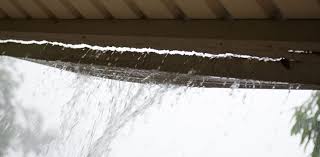
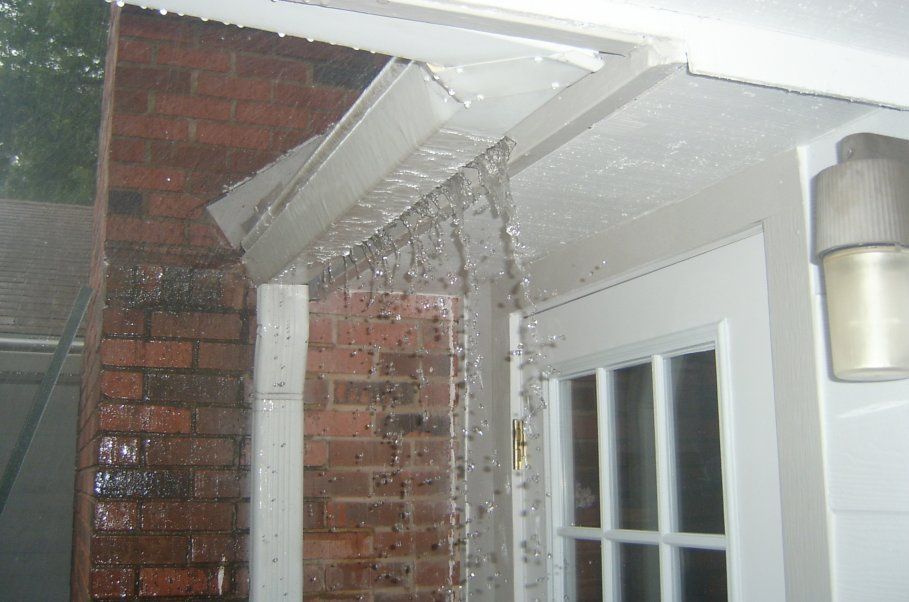
You’ll be able to tell if water is going behind your gutter by water marks on the wood and water damage. But, if you check out the gutters during rain you’ll be able to see it with your own eyes. Basically it appears to run right down the wall and gets into window frames and door frames.
If you have water going behind the gutter, it could be due to a couple different issues. Of course gutter clogs is the first thing we think of. But it could also be a loose gutter. If your gutter is loose from the wall, it is easy for the water to get behind it.
But what if your gutters are clean and also tight to the wall? Then what could it be? Well, the next thing to check after that would be the gutter pitch. If the gutter is pitched in the wrong direction and the water is pooling up in the gutter instead of draining, then that water can leak behind the gutter. It’s not common for the water to go behind the gutter due to pitch, but it can happen.
Another thing that could cause this, is the flashing or drip edge. All gutters are installed with a piece of flashing called “drip edge”. This piece of plastic or vinyl tucks under the shingles of your home, and leads the water into the gutter. It prevents the water from going under the shingles or behind the gutter.
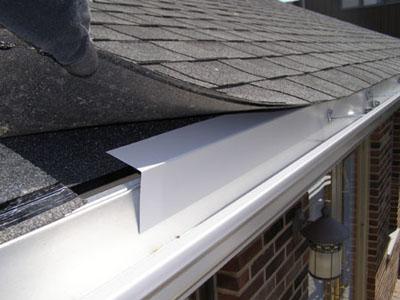
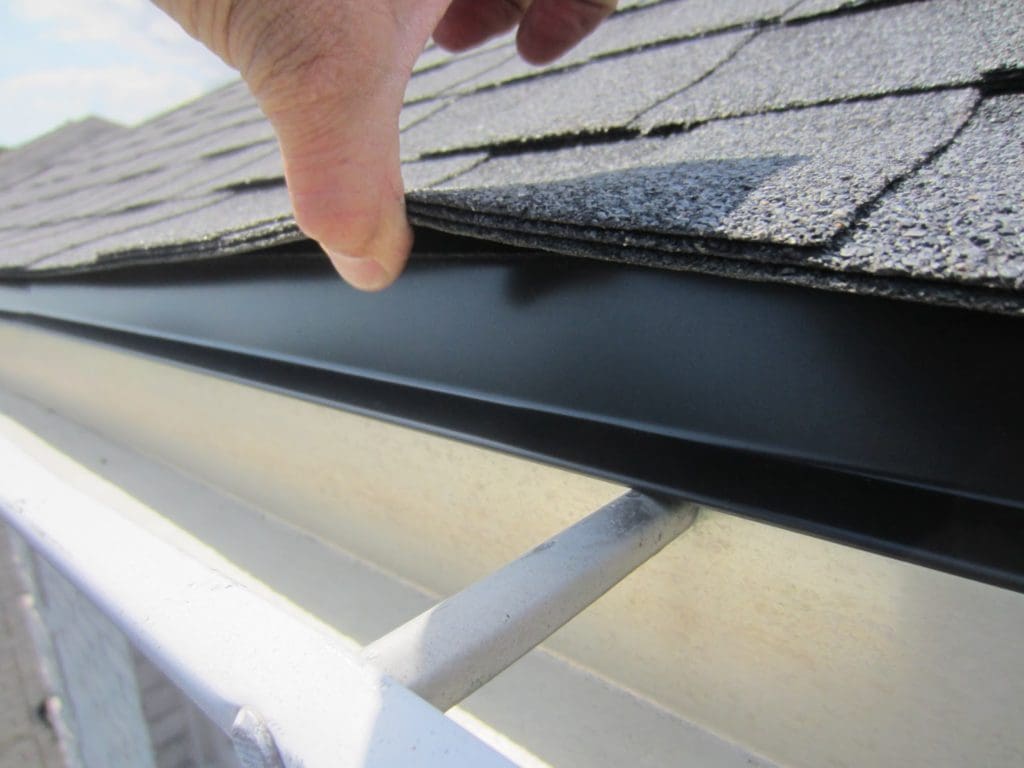
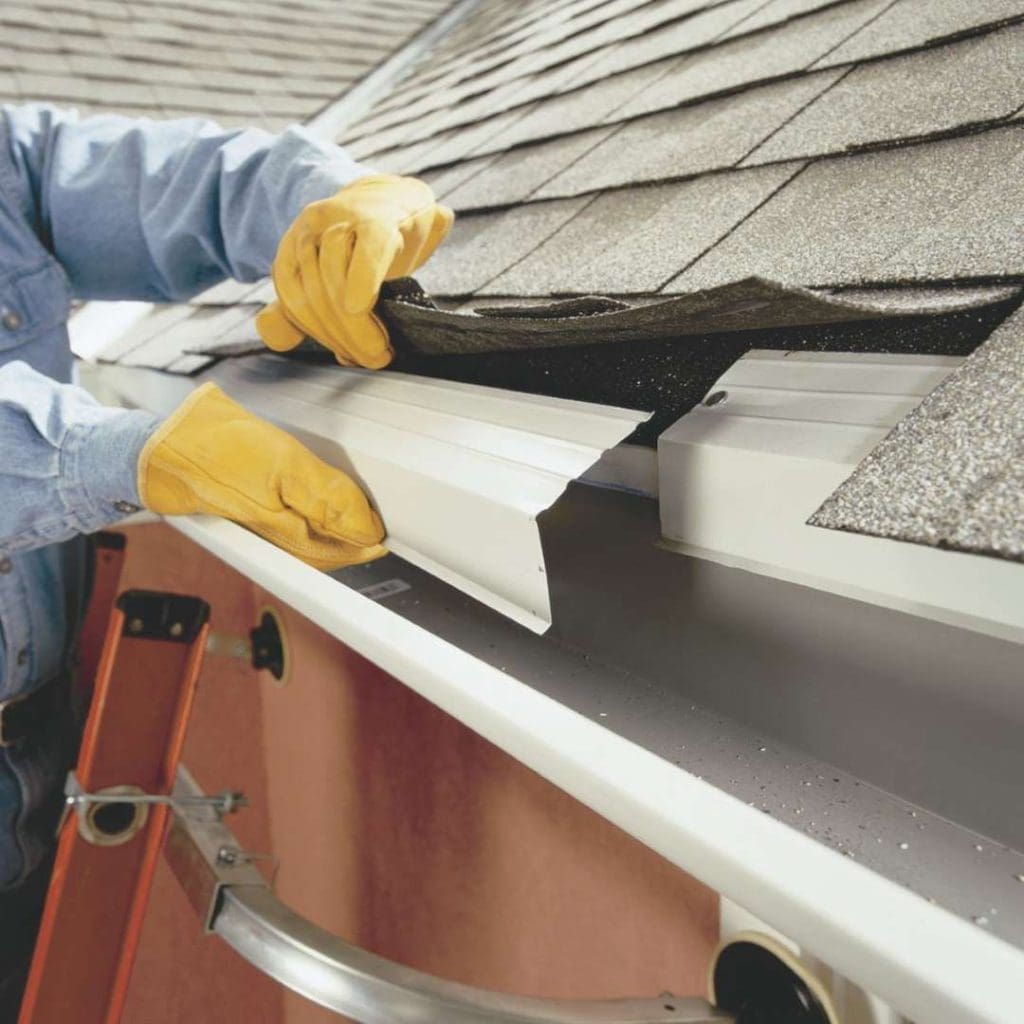
WATER GOING OVER THE GUTTER (NOT COLLECTING)
There are a couple things that could be causing the water to appear to go straight over the gutter. Keep in mind that during heavy rains and storms, nobody has gutters that catch all the water or handle all the flow. But, if you observe the water going straight over your gutter during a light or moderate rain, then there could be some more serious issues.
All of our normal suspects could also cause this to happen. (gutter clogs, gutter pitch, loose gutters, drip edge, etc…) However, for now we are assuming that you already checked that stuff and verified those are not the issue.
ROOF VALLEYS AND CONGESTED AREAS
This often happens in congested areas under roof seams where multiple sections of roof come together. The seam of two roof sections is called a “valley” and it becomes a channel for the water when it rains. All the water from the area combines to form a mini river and if the roof is steep enough or large enough, the water gains speed and goes straight over the gutter. The only remedy for this is installing splash guards to the problem area, or switching to larger gutters.
Basically, if your roof is too steep then the water gains speed. Another thing to keep in mind, is slate roofs and metal roofs do the exact same thing. The water seems to glide faster on those types of roofs. In extreme situations, water diverters can be installed to your roof to direct or slow down the water. Rain diverters get installed under the shingles, so this is technically a roofing repair. Some gutter companies may provide this service, but not all

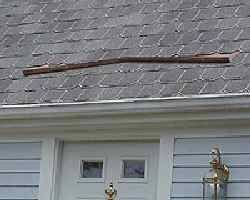
Another thing to consider that causes this same thing to happen, is if you have gutter covers in these same problem areas. Often times during heavy rains, the water will flow straight over certain types of gutter covers. Considering you’ve eliminated all the other possibilities it could be, and are certain this is what is causing the issues. Than you’re only left with a couple options. We would suggest removing the gutter covers in the problem areas.
WATER GOING OVER (CONTINUED)
Check out this short video that shows water pouring out of a loose gutter. The gutter has started to form a spout at the lip which is a tell tale sign the gutter is extremely loose.
If you’ve checked and verified that none of these are what’s causing your issue, then the only options left are that the gutters are simply set too low on your roof, or the roof edge/fascia board are set at the wrong angle.
If your gutters are set too low, you will be able to see it from the ground. Try looking at your gutters from a side view. Next, draw an imaginary line as if the roof shingles kept going. Now, if that straight line goes well over the gutter without touching it, then your gutters are set too low. They will need to be completely removed and raised.
The last option from this list, is when the roof edge itself is set at the wrong angle. Your only option here is to have “gutter wedges” installed behind your gutter. These are basically little triangles that correct the angle of your gutter.
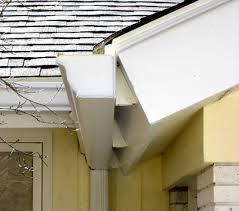

WATER DRIPPING FROM SOFFIT
Chances are if you have water dripping from the soffit area, than the water is getting behind the gutter. This is usually caused from a roof leak or damage to the drip edge. However, minor gutter repairs could be the issue as well. Such as clogs in the gutters, gutter pitch, loose gutter, etc. That is why we recommend making sure your entire gutter system is running efficiently. It is easier to diagnose issues when you narrow down the list.

My Gutter Pro
93 Monocacy Blvd. A-6
Frederick, MD 21701
(973) 852-6987
Does your home have gutters? If you answered yes, then you should be following My Gutter Pro on Facebook. You will receive seasonal reminders, DIY tips, FAQs, promo offers, contest and giveaways and much more. Don’t delay, join the My Gutter Pro team, today!!!
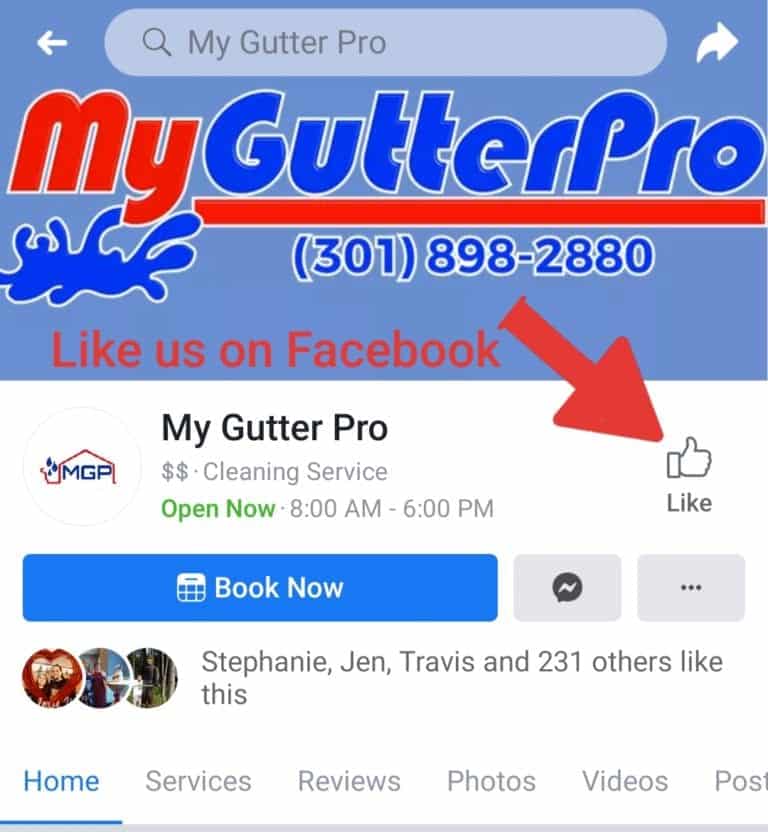
Click here for a Free Estimate
Here are some other helpful articles we’ve written to help explain everything “gutter related”:
Spring Gutter Cleaning Tips and FAQ’s
How Often Should I Clean My Gutters?
Gutter Accessories and Terminology Guide
Clogged Gutters Can Cause Big Problems
5 Common Pests That Live In Gutters
If you have any questions or if your issue was not addressed in this guide, feel free to send us an email and we will try to answer all questions. CLICK HERE to send us an email.

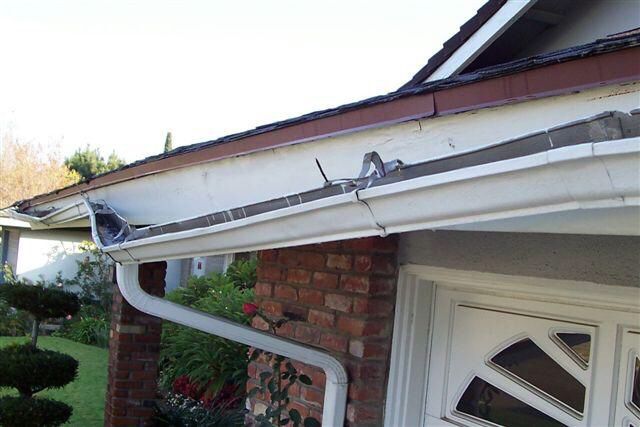


16 Responses
Such an interesting blog it is… Hope you will share more interesting blog near future.
Nice Blog!! The content you have shared is very elaborative and informative. Thanks a lot for sharing such a great piece of knowledge with us.
That’s a wonderful guide for gutter repairs. It is important to take care of the gutters properly as it might cause serious issues like smell, clogged pipelines, fungus etc. The above guide is really great and worth appreciation. Keep sharing!
Leaking gutter repair Tonbridge
I truly prize your piece of work, Great post.
I have not checked in here for some time as I thought it was getting boring, but the last several posts are good quality so I guess I’ll add you back to my daily bloglist. You deserve it my friend 🙂
I’m glad you talked about the importance of keeping your home’s gutters well-maintained. Recently, there was a huge storm, and it made us realize how our gutters are full of waste. My wife and I moved into this house a few months ago, and we suspect no one ever cleaned its gutters, so we’ll be sure to look into it. Thanks for the advice on how to prevent future gutter repairs.
Thanks for the guidance on how to re-seal a gutter. I was giving my home a quick inspection the other day to make sure everything is in good condition when I noticed that my gutters look cracked. I’ll be getting a professional to come and fix the problem because I don’t want to risk messing it up further if I try to repair it myself.
Nice Article…Very interesting to read this article. I have learned some new information. Thanks for sharing.
It made sense to me when you said gutter spikes are missing is an easy one to spot. You must first verify whether gutter spikes were utilized on your gutters. A friend of mine is complaining about so many leaks in his roof and gutters. He doesn’t have an idea of what to do first. This will be a good post to start on the replacement process.
Thanks for the reminder the fasteners are also important to consider when it comes to getting a full gutter replacement. I’d like to get a service like that soon because there are some warped parts on my gutter already. It would be best to get that fixed as soon as possible.
This is a very thorough gutter repair guide. For homeowners like myself, I feel confident in my abilities to repair my own gutter now.
Gutter repairs can be tricky but this blog makes it seem doable. Thanks for the great information!